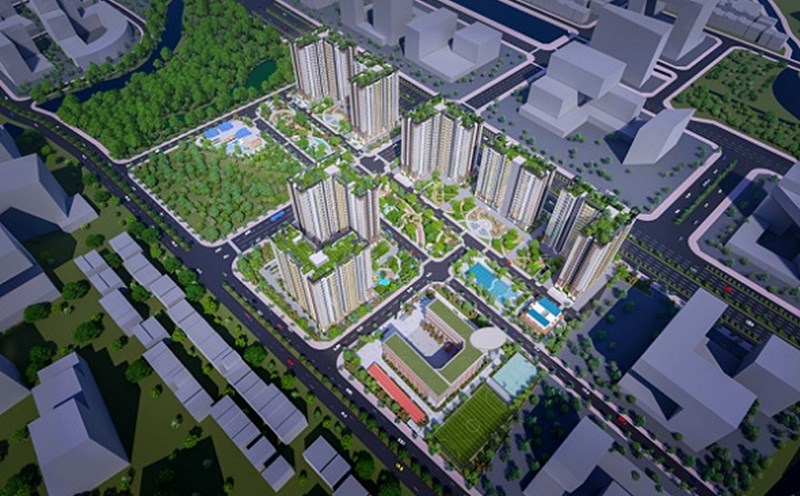On behalf of the National Assembly Standing Committee, National Assembly Chairman Tran Thanh Man has just signed and issued Resolution No. 1201/NQ-UBTVQH15 dated September 28, 2024 of the National Assembly Standing Committee on the arrangement of commune-level administrative units of Thai Binh province, period 2023 - 2025. The Resolution will officially take effect from November 1, 2024.
According to the content of this resolution, Dong Hung district will establish Lien An Do commune on the basis of merging the entire natural area and population of the three communes of Do Luong, An Chau and Lien Giang. After establishment, the new Lien An Do commune has a natural area of 13.14 km2, a population of 18,457 people, bordering Dong La, Dong Son, Me Linh, Nguyen Xa and Phu Luong communes of Dong Hung district; and also borders Hung Ha district and Quynh Phu district.
Phong Duong Tien commune was established on the basis of merging the entire natural area and population of the three communes of Chuong Duong, Hop Tien and Phong Chau. After establishment, the new Phong Duong Tien commune had a natural area of 11.98 km2, a population of 16,526 people; bordering the communes of Lien Hoa, Lo Giang, Me Linh, Minh Phu, Nguyen Xa, Phu Chau, Phu Luong and Thang Long of Dong Hung district.
In addition, Xuan Quang Dong commune was established on the basis of merging the entire natural area and population of the three communes of Dong Quang, Dong Xuan and Dong Dong. After establishment, the new Xuan Quang Dong commune has a natural area of 11.34 km2, a population of 19,212 people; bordering the communes of Dong Cac, Dong Duong, Dong Hop, Dong Hoang, Dong Vinh, Ha Giang, Phu Chau and Trong Quan of Dong Hung district; and bordering Thai Binh city.
Thus, after the arrangement, Dong Hung district has 32 commune-level administrative units, including 31 communes and 1 town.
In Quynh Phu district, Trang Bao Xa commune was established on the basis of merging the entire natural area and population of the three communes of Quynh Bao, Quynh Trang and Quynh Xa. After establishment, the new Trang Bao Xa commune has a natural area of 12.46 km2, a population of 16,919 people; bordering An Vinh, Dong Hai, Quynh Hoi, Quynh Hung, Quynh My, Quynh Nguyen communes of Quynh Phu district and bordering Dong Hung district.
After the arrangement, Quynh Phu district has 35 commune-level administrative units, including 33 communes and 2 towns.
In Kien Xuong district, Thong Nhat commune was established on the basis of merging the entire natural area and population of the three communes of Dinh Phung, Nam Cao and Thuong Hien. After establishment, the new Thong Nhat commune has a natural area of 12.74 km2, a population of 16,098 people; bordering the communes of Binh Minh, Hoa Binh, Le Loi, Quang Lich, Thanh Tan, the town of Kien Xuong district and bordering Tien Hai district.
Hong Vu commune was established on the basis of merging the entire natural area and population of the three communes of Vu Binh, Vu Hoa and Vu Thang. After establishment, the new Hong Vu commune had a natural area of 13.80 km2, a population of 17,141 people, bordering the communes of Quang Binh, Minh Tan, Vu Cong and Vu Trung of Kien Xuong district; and bordering Vu Thu district and Nam Dinh province.
Thus, after the arrangement, Kien Xuong district has 29 commune-level administrative units, including 28 communes and 1 town.
In Tien Hai district, Dong Quang commune was established on the basis of merging the entire natural area and population of the three communes of Dong Trung, Dong Quy and Dong Phong. After establishment, the new Dong Quang commune has a natural area of 15.67 km2, a population of 16,880 people, bordering the communes of Dong Co, Dong Hoang, Dong Minh, Dong Tra, Dong Xuyen, Tay Luong, Tay Ninh and Tien Hai town of Tien Hai district; and bordering Thai Thuy district;
Ai Quoc commune was established on the basis of merging the entire natural area and population of Tay Phong and Tay Tien communes. After establishment, the new Ai Quoc commune had a natural area of 10.13 km2, a population of 9,133 people, bordering the communes of Bac Hai, Dong Lam, Nam Chinh, Nam Cuong, Nam Ha, Nam Tien, Phuong Cong, Tay Giang and Van Truong of Tien Hai district.
Nam Tien commune was established on the basis of merging the entire natural area and population of Nam Thanh and Nam Thang communes. After establishment, the new Nam Tien commune had a natural area of 9.70 km2, a population of 19,366 people, bordering Ai Quoc, Nam Chinh, Nam Cuong, Nam Hung, Nam Thinh and Nam Trung communes of Tien Hai district.
Thus, after the arrangement, Tien Hai district has 28 commune-level administrative units, including 27 communes and 1 town.
In Hung Ha district, Quang Trung commune was established on the basis of merging the entire natural area and population of the three communes of Dan Chu, Diep Nong and Hung Dung. After establishment, the new Quang Trung commune has a natural area of 17.68 km2, a population of 23,379 people, bordering the communes of Duyen Hai, Doan Hung, Thong Nhat and Van Cam of Hung Ha district; and at the same time bordering Quynh Phu district and Hung Yen province.
After the arrangement, Hung Ha district has 33 commune-level administrative units, including 31 communes and 2 towns.











